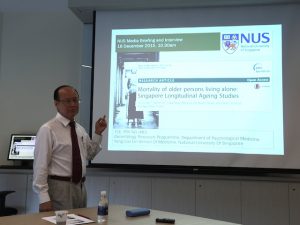Older persons living alone have higher chance of dying prematurely
First of its kind study found that men who lived alone had an increased mortality, compared to women who lived alone.

A/Prof Ng Tze-Pin sharing the findings of the mortality study, which is part of the Singapore Longitudinal Ageing Studies.
Older persons who lived alone had 1.7 times faster rate of dying prematurely compared to their counterparts who lived with others including their spouse and family, according to a mortality study that was a part of the Singapore Longitudinal Ageing Studies (SLAS), which is on-going and focuses on four themes including dementia, depression, frailty and successful ageing.
The mortality study also found an increased mortality in men than women living alone – the death rate among men who lived alone was 2.8 times higher than that of men who lived with others, and for women, the rate was 1.2 times higher.
This study is the first of its kind done in Singapore and Asia, excluding Japan, and it shines the light on older people living alone, a number which is set to increase in time to come. According to the Singapore Department of Statistics, in 2012, there were 35,000 older persons living alone and in year 2030, this will increase to 83,000.
The eight-year study interviewed 2,553 Chinese participants (the number of voluntary participants from other races were not sufficient) aged 65 and over living in one- or two-room HDB housing in Geylang, Bedok, Aljunied and MacPherson, who were single, divorced or widowed. Associate Professor Ng Tze-Pin, from the National University of Singapore’s psychological medicine department and the lead researcher in the study, shared that the participants were mostly poor.
“They represent a vulnerable group with social isolation, loneliness, poor access to healthcare, and adverse health outcomes.” However, he prefaced that older people who live alone are not a homogeneous group with some who choose to live alone, and are healthy and independent.
Most of the studies on mortality have been done in the West and Japan, and some have found a mixed picture that there is increased mortality as well as some studies noting no worse physical health and functional status. A/Prof Ng said: “It really depends on the country and the social and healthcare system.”
The mortality study found a total of 189 participants lived alone, and they tend to be older and women. After the follow-ups for an average of three years per person, the researchers found that 227 participants died. Though they did not have more information on the participants’ chronic diseases and medical complications, they found that older persons may develop severe illness due to poor treatment, care and support, which is mainly due to the lack or loss of a spouse, especially among men.
A/Prof Ng said that the coordination of care with the vulnerable groups could be improved. He said, “VWOs have a list of people living alone in the HDBs and they make frequent visits. If the older persons fall sick, the VWOs are able to help bring them to the hospital. We need to look at their care when they are sick, transfer of care between healthcare and social sector, etc.”
He also added that social intervention could help as well as more physical activity so the older persons will be less depressed. However, he shared that social intervention could be difficult, as it would require older persons to be “more participatory”. There is a “barrier of them not wanting to go and this needs to be overcome,” he said.
Next for the SLAS study is looking at those over the age of 80 as well as 90 who are healthy and independent, and with hardly any chronic diseases. This study will be released in three years, said A/Prof Ng.

0 Comments